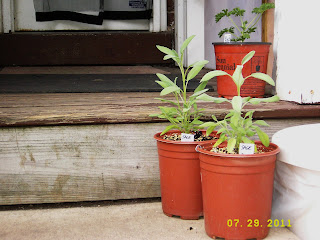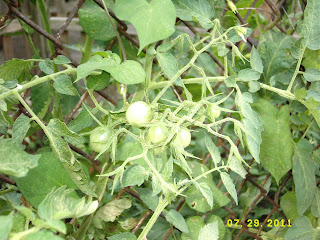 |
| Citronella-scented Geraniums |
The tomatoes are ripening here in Columbus, Ohio and our mouths are starting to water for fresh homemade salsa and capellini primavera! I hope your garden is growing well this summer.
We experimented with taking cuttings from citronella-scented geraniums, rosemary and lavender this year. We used an organic rooting gel and have found that the rosemary and lavender seem to benefit from a mixture of about 25 - 30% sand with 70 - 75% potting soil. Not all of them survived, but the ones that did are growing more each day.
 |
| Common Sage grown from seed |
 |
| Pink & Yellow Brandywine Tomatoes |
Taking a walk through our backyard... we encountered space as our major limiting factor this year with our business. Once we had made all of our deliveries, our yard was filled with shelves of leftover tomato & pepper plants that we had hoped to plant in the ground at our friend's property. We finally got to till seven beds there on June 27, but our other contracting work picked up and we were unable to go back to plant. We held onto the rootbound tomato & pepper plants until it was too late, thus missing the next planting cycle.
 |
| Hornworm larvae |
Gardeners Beware of the Hornworm Caterpillar! This voracious creature will be the bane of your container garden unless you check your plants DAILY and remove any hornworms. According to Mother Earth News, natural pesticides that control hornworms inclue the bacteria bT (Bacillus thuringiensis) and a substance called Spinosad that is produced by Saccharopolyspora spinosa bacteria. Please note that spinosad also kills beneficial insects such as honeybees and should be used sparingly & only if absolutely necessary.
 |
| Hornworm victim (now recovering - all leaves eaten off within a few hours by 2 hornworm caterpillars) |
I came outside one evening to discover that something had completely stripped every single leaf off an unfortunate Yellow Brandywine tomato plant. A closer look revealed two enormous, fat green caterpillars: the notorious hornworms. This happened within the space of only a few hours. Being a good gardener requires constant vigilance by making daily rounds.
 |
| Herbs |
Our transplant wholesale business this spring was a success. Though I wish we could offer more potted culinary herbs at harvest time, we have simply run out of space in our tiny postage stamp portion of the backyard. The herb cuttings are growing slowly, and I would like to see if they will continue to grow indoors over the winter. If they do, we will have a decent stock from which to propagate more.
 |
| Sweet Basil and Rosemary |
 |
| Mortgage Lifter in 2-ft container |
In the fall, we plan to divide the roots of 3-year old perennials that we planted by the lake before our wedding in 2009. These include hybrid daylilies, purple echinacea, butterfly plant, butterfly balm, and lavender. We would like to be able to offer perennials for sale in the future.
 |
| Golden Calwonder Bell Pepper |
We did not dismantle the greenhouse but only removed the top panel of plastic over the air-conditioner. This way, our tomato plants are protected from late blight by being shielded from having their leaves get wet when it rains. We water them at the bottom and gently shake blossoms to ensure pollination. I am a little worried it may be too hot & humid inside the vented greenhouse for them to set fruit, but especially the Black Krim is known for its ability to set fruit despite high humidity.
 |
| Black Krim, Mortgage Lifter and Pink Brandywine |
We up-potted one of each variety of our heirloom tomato seedlings to grow in our container garden, plus an extra Mortgage Lifter and a couple of extra Brandywines. We have ten tomato plants in containers on the patio, and another seven next door growing through the fence. I have read that tomatoes are pollinated by vibration, and that there is less concern about cross-pollination of heirloom varieties due to this. However it will be interesting to find out if the seeds remain true.
 |
| Yellow Brandywine (left) & Cherokee Purple (right) |
One of our major costs this year was potting soil. A cubic foot of potting soil cost about $4.50 for the organic brand we used, and we went through at least 16 bags. Until we are in a place where we can produce our own organic potting mix, we will have to continue to purchase it - a major expense.
I also want to grow fresh culinary herbs for sale in the future, mainly sweet basil and flat-leaf parsley. Although we did not get to plant the garden of our dreams this summer, we hope to grow Asian greens, spinach, lettuce and other cold-season vegetables under high tunnels this fall & winter on the beds we tilled.
 |
| Chocolate Cherry Tomatoes growing through the fence |
Country Folks Grower Midwest, a monthly horticulture trade paper, reports in their May 2011 edition that the use of high tunnels to extend the growing season here in Ohio continues to grow. The use of high tunnels is clearly the next step in the evolution of sustainable agriculture, and it could add immeasurably to the wealth and true homeland security of Ohio if more small farmers adopted this technique. The high tunnel production method has been refined and documented by Eliot Coleman in his books The New Organic Grower and The Winter Harvest Handbook.
 |
| the garden next door growing through the fence |
The Sweet Basil and Flat-Leaf Parsley plants growing next door in our neighbors' garden are huge, shiny and green and full of vitamins and life essence. We top the basil periodically to remove flowerheads and encourage leaf production.
How To Preserve Fresh Basil
To preserve the fresh greenness of the basil leaves, I chop them along with 3 or 4 cloves of garlic, put it in a jar, and pour olive oil over the mixture until it is submerged and squeeze lemon juice over the top. In this way the basil is preserved for several weeks in your fridge. I scoop mine out by the tablespoon and use it to make aioli (by adding mayonaisse) which adds light years to the dimension of a plain old sandwich.
 |
| Black Beauty eggplants just starting to flower |
Business Snapshot:
From late April through early June, ERB Gardens made six deliveries to three local clients. We sold 652 plants and had 305 plants left over, mostly tomatoes that never got up-potted or planted. Our plants cost roughly $.21 each to produce, not counting our labor/time. According to wikipedia’s definition of profit margin, we have a 13% profit margin so far, and next year that is expected to increase due to initial investments we will not have to make again next year. Our markup appears to be 852% if we sell each plant for $2.00 wholesale or $36/tray, but that figure decreases if we include the kind of labor/time data we will need to collect next season. If we estimate cost of electric and labor/time to equal a rough cost/plant of $.75, our more realistic projection of markup is about 167%. The retail markup is 50% for our buyers if they sell them for $3.00 each.














